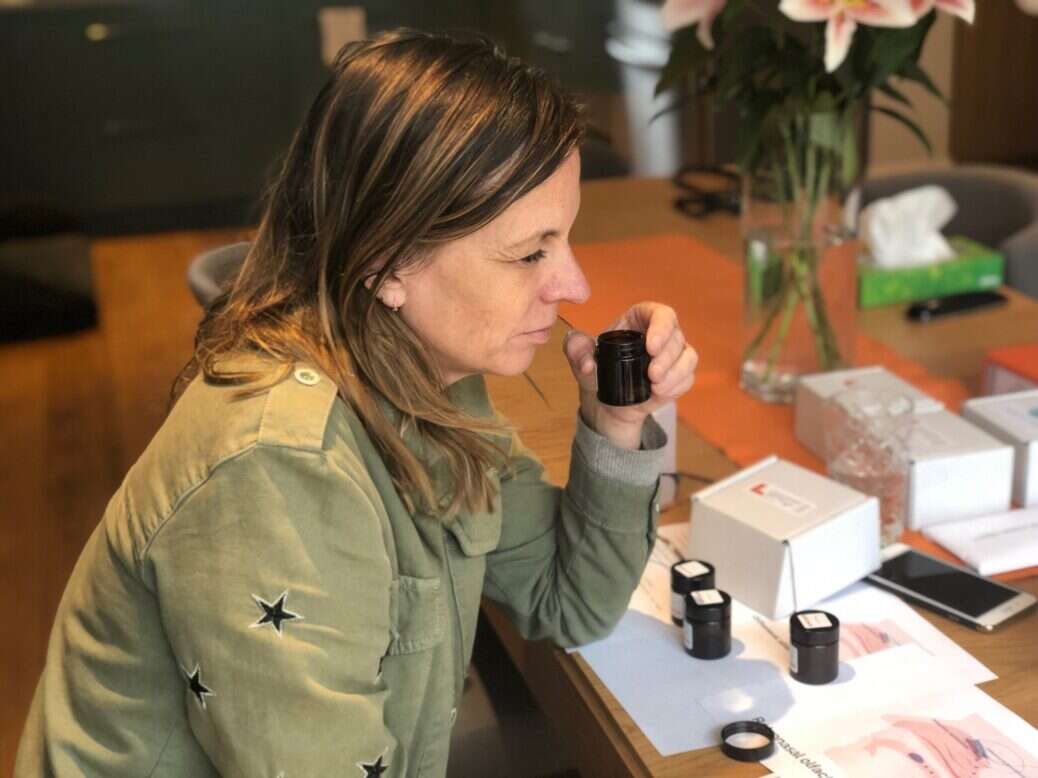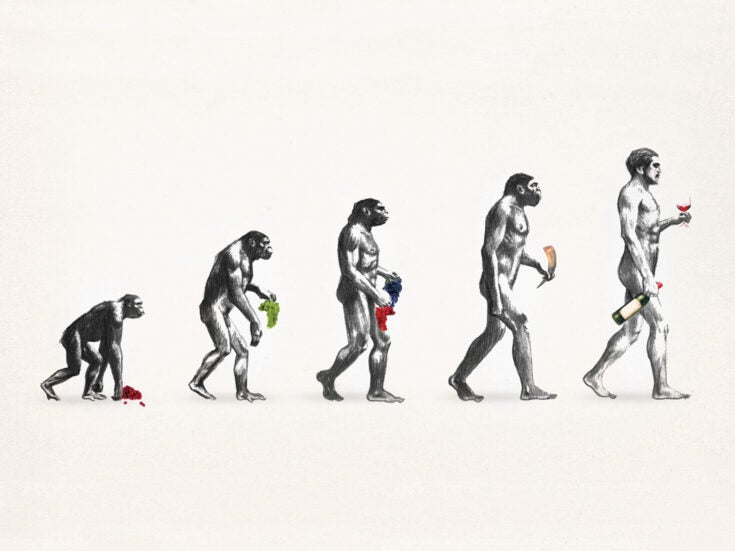
Barry C Smith presents a fascinating overview of the frequently documented phenomenon of smell loss throughout the Covid-19 pandemic, which has brought further misery to millions. But it has also improved our understanding of olfactory dysfunction and the vital role of a still-undervalued sense.
It was late February 2020 when olfactory researchers began to hear reports about medical practitioners suddenly losing their sense of smell. Clinicians who had been treating patients with coronavirus discovered they could no longer smell antiseptic, food, or anything very much. It was the first ominous sign of a link between Covid-19 and smell loss.
As olfactory researchers, we had known about post-viral smell loss, which pre-pandemic affected as many as 5 percent of the population, but it was not unusual for these conditions to go untreated and for people to be told by their doctors they must just have to live with them.
This may explain why healthcare professionals were slow to pick up on loss of smell as a symptom of Covid-19. People presented a wide range of symptoms, including fever, headache, and shortness of breath, but initially little attention was paid to the uptick in smell loss, and many people who were suddenly deprived of smell had no other symptoms.
In March 2020, reports gradually began to emerge—first from China, then from Iran, Italy, Germany, France, then from the UK and the US, following the pattern of the spread of the virus—of a notably high incidence of people, many of them healthcare workers, reporting a sudden loss of smell and taste.1
Much of the impetus for research on olfactory dysfunction comes from patient advocate groups, such as the UK charities AbScent and Fifth Sense, set up in response to the lack of interest the medical profession showed in anosmia sufferers. Ironically, it was these charities that medics from Iran and Italy contacted for more information when they noticed the lack of smell in themselves and their patients.
Around the same time, a Google Trends graph of searches showed a vertical spike for the words “loss of smell” or “anosmia” among its queries, and chemosensory researchers were beginning to realize that they needed to coordinate globally to study the causes and effects of this outbreak of anosmia.
A survey by the newly formed Global Consortium for Chemosensory Research, which spanned 60 countries and more than 40 languages, would soon show that alteration to smell and taste was the most reliable indicator, even among asymptomatic carriers, of coronavirus. It would take governments and public-health bodies much longer, however, to add loss of smell and taste to their lists of official symptoms, and where a quick response was needed, there is no doubt that this delay put lives at risk.
As early as March 2020, UK surgeon and rhinologist Professor Claire Hopkins and her colleague Professor Nirmal Kumar issued a statement warning that smell loss was a marker of Covid-19, but it was not until May that Public Health England admitted loss of smell and taste as an official symptom. Luckily, Professor Hopkins had suggested to her colleague Professor Tim Spector that he include loss of smell and taste among the list of symptoms on his symptom-tracking app Zoe, and worldwide collection of data from the app helped confirm that loss of smell and taste were the most reliable indicators of Covid-19 infection.
Anosmia to parosmia: bad to worse
While many people reported that food didn’t taste of anything, the majority (not all) of such cases were due to the loss of smell. Before Covid, people simply didn’t know how much smell contributed to what they call tasting. All the tongue can provide is the taste of salt, sweet, sour, bitter, and umami. The flavors of fruits, the difference between lamb and beef, the pleasures of coffee and chocolate—all of these are due to smell, where aroma molecules, released as we sip or chew, travel from the mouth and up through the back of the throat to receptors in the olfactory epithelium at the bridge of the nose.
It is the combination of these olfactory signals, with inputs from receptors on the tongue, that the brain combines to produce experiences of flavor. When people said they had lost their sense of taste, my colleagues and I would ask them to put a drop of lemon juice, or a sprinkle of salt or sugar on the tongue. Could they taste any of these items? Yes, they would say, but that was all they could taste.
They were discovering for the first time just how important smell is to the enjoyment of flavor. A hallmark of Covid-related anosmia was its sudden onset. One patient described drinking his coffee then putting it down, and the next time he returned to it, there was nothing but the taste of slightly bitter hot water.
The misery many experienced (and continue to experience) due to smell loss should not be underestimated. In a compelling first-person account of Covid’s impact on smell, Paola Totaro vividly captures what it is to be without it:
At the dinner table, red wine tasted like salty water, white wine like a mild, odorless vinegar. My favorite apéritif, gin, was barely perceptible in the overwhelming, cloying sweetness of the tonic. Steak felt like biting into a slab of flabby leather, chicken a horrifying, bony, rubber, while dark chocolate, my favorite, felt like biting into unscented soap.”2
This predicament was bad enough, but for many anosmia sufferers, worse awaited them when their sense of smell returned. For reasons we have yet to understand, the return of smell, at first bit by bit—rosemary but nothing else, then mint but still no odor of cleaning fluids or hand sanitizer—lasted for a few weeks, when people initially described their sense of smell as having returned to normal, before familiar odors of coffee, meat, and mint were increasingly perceived as distorted and disgusting.
This is parosmia, and for sufferers, coffee was a regular culprit. One patient we interviewed described it as smelling like “fruity sewage.” Other descriptions for the parosmic distortions of food odors included bin-liner juice and the slime on a harbor wall at low tide. Many people found parosmia harder to bear than anosmia, rendering the act of eating aversive and leaving them constantly battling with nausea.
The numbers are considerable. At the time of writing, we know that there have been more than 601 million cases of Covid-19, and of those, it is estimated that around 65 percent suffered some alteration to their smell or taste. Many of those who lost their sense of smell recovered it after two to three weeks.
But for others, it took much longer. Some have still not recovered their sense of smell since March 2020. Lingering, too, are the prolonged cases of parosmia, with a regular diet of disgust and disappointment when it comes to favorite foods and drinks.
It is estimated that of the 65 percent of those who experienced olfactory disruption, 10 percent will have long-term problems, and some will lose their sense of smell altogether. These are large numbers, meaning many people are having to live with the long-term effects of smell dysfunction.
Such disruptions to smell can take many forms: anosmia (loss of olfactory capacity); hyposmia (reduced olfactory capacity); parosmia (distorted perception of odors); and phantosmia (the experience of an odor in the absence of an odor source). Many phantom smells are described as the smell of burning, or a chemical or gasoline smell.
What have we learned?
Throughout the pandemic, chemosensory scientists, clinicians, patients and their advocates, neurobiologists, philosophers, and food scientists have been involved in intense collaborations to discover more about the symptoms, the causes, the consequences, potential treatments, and management of SARS-CoV-2’s impact on our sense of smell. What have we learned?
We know the nose is the primary site for infection. (This made it hard for my colleagues and me to see people wearing a face mask as a chin strap or a mouth guard.) The coronavirus binds to ACE2 cells in the nose, and there is a plethora of such cells in the olfactory epithelium.
Interestingly, the virus doesn’t attack the olfactory receptors in the epithelium directly. It is the supporting, sustentacular cells to which the virus binds, and these are the structures that hold the olfactory receptor neurons in place. (Think of the sustentacular cells as the gums and the olfactory receptor neurons as the teeth.)
When the sustentacular cells collapsed, the little hairs or cilia that house the olfactory receptors fell out. We also know that the inflammatory responses to diseased cells often led to cytokine storms, and the splashback from these did further damage to olfactory receptor neurons. This may explain the difference between those who recovered their sense of smell quickly and those who suffered prolonged damage.
Normally, our olfactory receptors regenerate every two to three months—they are among the fastest-growing cells in the body and used in research as stem cells—and for many the recovery was quick. But why do so many people who recover their sense of smell go on, after a short gap, to experience parosmia with its palette of distorted odors?
It’s unclear. Though what we have discovered is that molecular compounds trigger the disgusting experience of distorted odors in food and drink. Just before the outbreak of the pandemic, a dedicated group of patients, clinicians, and sensory scientists had gathered at the University of Reading to propose a project on post-viral parosmia to identify the range of foods, drinks, and household items whose odors were perceived as distorted and disgusting and to try to identity the cause.
Due to the large numbers of people describing the distress of eating, my colleagues and I were able to obtain responses from a large patient group that helped us identity the range of foods that provoked the disgust response.3 These were coffee, roasted meats, onion, garlic, eggs, and mint.4
Then, between lockdowns, food scientist Dr Jane Parker invited patients into her lab at the University of Reading, where she sat them in front of a gas chromatography olfactometry column—a device that breaks down the volatile molecules in a food and presents them to the nose of participants one by one. By this method, it was possible to identify the molecular triggers that provoke the parosmia response.
The key compounds were mostly sulfur compounds that occur in low concentrations in food and liquids, pyrazines that occur in roasted, Maillard-reaction foods.5 These odor-active compounds seem to dominate the overall aroma profiles of foods for those with parosmia.
Perhaps they are boosted—or alternatively, they are not masked—because perceivers are unable to detect other volatiles. (The major culprits were 2-furanmethanethiol, 2-methyl 3-funthiol, 2,3 diethyl-5-methylpyrazine and 2-furanmethyl methyl disulfide.) Knowing the triggers enables sufferers to find workarounds in foods without these compounds.
A curiosity of parosmia is what we could call its fair-is-foul-and-foul-is-fair character. For while many foods smell awful, patients will say—if prompted—that their feces smell rather pleasant. Imagine how distressing it must be when food smells like feces and feces smells like food.
However unpleasant to endure, having parosmia is a sign of recovery, and a very reliable indicator that the sense of smell will regularize over time. At first, patients describe “that parosmia smell,” but increasingly they make distinctions between different distorted smells, and this finer discrimination typically heralds an important step towards smelling as normal.
Any good news?
Beyond the shocking experience of no longer being able to taste food or wine, long-term smell loss has a debilitating effect on people’s sense of themselves and their connection to the world around them. Patients nearly always speak of feeling cut off from the world, as if behind glass, or as feeling alien in their own home.
Research undertaken with patients throughout the course of the pandemic revealed the profound psychological effect smell has had on people’s sense of wellbeing. Here are some indicative quotes from patients (with permission):
“You feel so detached from reality when you can’t smell your surroundings.”
“I feel discombobulated, like I don’t exist. I can’t smell my house and feel at home. I can’t smell fresh air or grass when I go out. I can’t smell the rain. […] I am mildly depressed about it and cry sometimes.”
“I’ve found that not smelling like ‘myself’ has had a great impact on me. I am so used to my own smell, that smelling something else is alien. I don’t feel like I am me anymore.”6
Depression is a frequent side effect of anosmia. The world seems to have lost a dimension, to be flatter, less bright. And because of smell’s links with the limbic system, shrinkage in the volume in the olfactory bulb is treated as a biomarker for depression.
And the worrying thing for those who have recovered from post-
Covid smell loss is the recent evidence coming out of the Karolinska Institute in Sweden that olfaction in this group may have undergone changes resulting in permanently lowered olfactory capacity.7
Is there any good news, any upside? I think there is. There is increasing evidence that repeated smell training produces improvements in those suffering from post-viral anosmia or hyposmia.8
Sniffing four essential oils first thing in the morning and last thing before bed can improve one’s capacity to detect odors, and it appears to offer a protective benefit against age-related decline in one’s olfactory capacities. This is good news for wine enthusiasts and wine professionals whose trained noses are used to exercising their sense of smell in a way analogous to smell training.
Another positive to come out of the pandemic is the raising of awareness of our sense of smell and the recognition of its importance for our quality of life. Advances are also being made in our understanding of smell and the brain, pointing the way to new research questions.
But by far the most important outcome of these dark times is the way patients, olfactory scientists, and healthcare professionals have worked together to advance our understanding of anosmia and parosmia and to improve patient care.
By describing their symptoms in detail, patients have provided key insights into the mechanisms that scientists are trying to uncover, and with these findings, the scientists and patients have helped inform clinicians about the conditions patients are going through and about what can be done to treat or just manage those conditions.
By becoming a gateway to reliable information, patient advocacy groups, armed with the latest science, can be trusted by medics, who can refer their patients, taking some of the burden from primary healthcare. We are all more knowledgeable about our sense of smell, and there is hardly anyone now who hasn’t heard of anosmia.
Smell has been much neglected in the historical, literary, philosophical, and scientific study of the senses. But lessons are being learned: Smell is a use-it-or-lose-it sense, and it pays to exercise it. You don’t know what you’ve got till it’s gone; and for wellbeing, smell matters.
Notes
1. SB Gane, CE Kelly, and C Hopkins, “Isolated Sudden Onset Anosmia in COVID-19 Infection. A Novel Syndrome,” Rhinology 10 (2020). RC Gerkin, K Ohla, MG Veldhuizen, PV Joseph, CE Kelly, et al, “Recent Smell Loss Is the Best Predictor of COVID-19 among Individuals with Recent Respiratory Symptoms,” Chemical Senses 46 (2021).
2. Paola Totaro and Robert Wainwright, On the Scent: Unlocking the Mysteries of Smell and How Its Loss Can Change Your World (Elliott & Thompson, London; 2022), p.xi.
3. JK Parker, CE Kelly, B Smith, A Kirkwood, C Hopkins, S Gane, “Patients’ Perspectives on Qualitative Olfactory Dysfunction: Thematic Analysis of Social Media Posts,” JMIR Form Res 2021;5(12):e29086
4. JK Parker, L Methven, R Pellegrino, BC Smith, SB Gane, and CE Kelly, “Emerging Pattern of Post-COVID-19 Parosmia and its Effect on Food Perception,” Foods 11 (2022), p.967.
5. JK Parker, CE Kelly, and SB Gane, “Insights into the Molecular Triggers of Parosmia Based on Gas Chromatography Olfactometry,” Communications Medicine 2, article 58 (May 2022).
6. DL Burges Watson, M Campbell, C Hopkins, B Smith, CE Kelly, and V Deary, “Altered Smell and Taste: Anosmia, Parosmia and the Impact of Long Covid-19,” PLoS ONE 16(9) (2021):e0256998.
7. B Iravani, MG Peter, A Arshamian, MJ Olsson, T Hummel, HH Kitzler, and JN Lundström, “Acquired Olfactory Loss Alters Functional Connectivity and Morphology,” Scientific Reports 11:1 (2021), 16422.
8. T Hummel, K Rissom, J Reden, A Hähner, M Weidenbecher, and K-B Hüttenbrink, “Effects of Olfactory Training in Patients with Olfactory Loss,” The Laryngoscope 119 (2009), pp.496–99. K Pekala, RK Chandra, JH Turner, “Efficacy of Olfactory Training in Patients with Olfactory Loss: A Systematic Review and Meta-Analysis,” International Forum of Allergy & Rhinology 6 (2016), pp.299–307.






